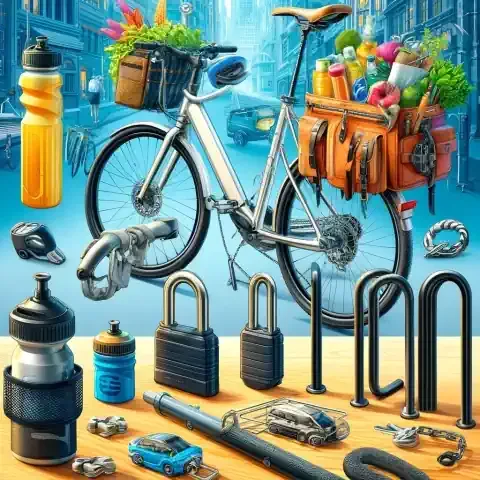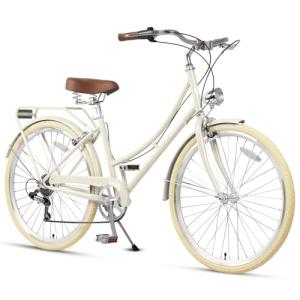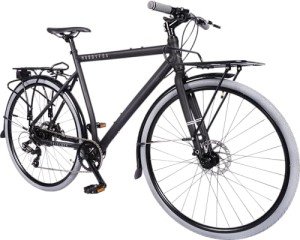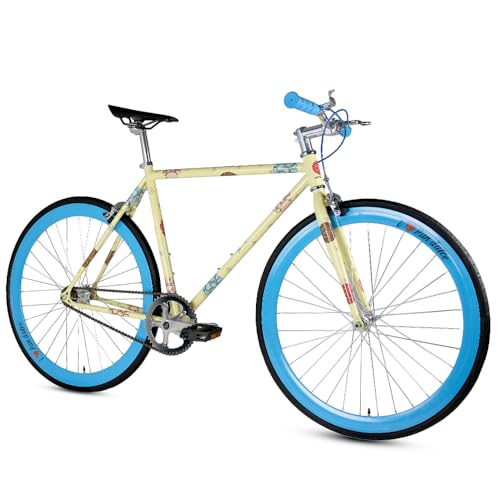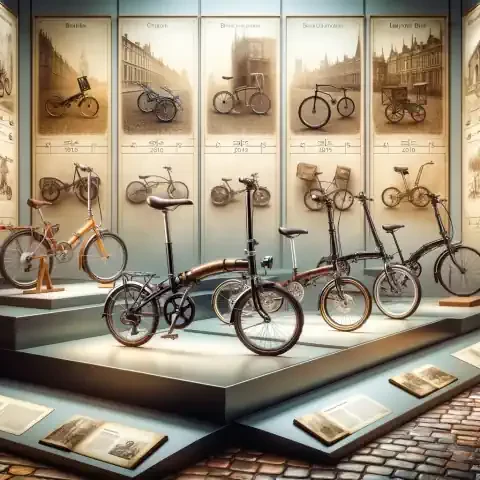Bike Accessories for Urban Cycling
The Changing Landscape of Urban Mobility
Urban centers across the globe are experiencing a profound transformation in their approach to transportation. Long gone are the days when cars dominated the streets, leaving little room for alternative modes of mobility. The rise of urban cycling symbolizes a paradigm shift towards sustainable, efficient, and people-centric transportation solutions.
Environmental Imperatives
At the heart of this resurgence lies a growing awareness of the environmental impact of traditional modes of transportation, particularly automobiles. As cities grapple with worsening air quality, traffic congestion, and carbon emissions, urban cycling emerges as a viable antidote. Unlike motor vehicles, bicycles produce zero emissions, consume minimal resources, and occupy significantly less space, making them an inherently eco-friendly mode of transport.
Health and Well-being
Beyond its environmental benefits, urban cycling offers a myriad of health advantages for individuals and communities alike. In an age marked by sedentary lifestyles and rising rates of chronic diseases, the bicycle represents a simple yet potent tool for promoting physical activity and improving public health. Regular cycling not only strengthens cardiovascular health, but it also enhances mental well-being, reduces stress, and fosters a sense of connectedness with one's surroundings.
Economic Considerations
From a socioeconomic perspective, the resurgence of urban cycling brings with it a host of economic advantages. By reducing dependence on motor vehicles, cities can alleviate the financial burden associated with road maintenance, parking infrastructure, and healthcare costs stemming from traffic-related accidents and air pollution-related illnesses. Furthermore, investing in cycling infrastructure and promoting bicycle-friendly policies can stimulate local economies by bolstering tourism, supporting small businesses, and creating job opportunities in the cycling industry.
Social and Cultural Shifts
The resurgence of urban cycling is not merely a transportation trend but a cultural phenomenon that reflects shifting societal values and priorities. In an era characterized by hyper-connectivity and urbanization, the bicycle offers a means of reclaiming autonomy, freedom, and human-scale mobility in an increasingly congested and impersonal urban landscape. Cycling fosters a sense of community, encouraging social interactions, spontaneous encounters, and a shared sense of belonging among diverse groups of people.
Technological Innovations
Advancements in technology have played a pivotal role in catalyzing the renaissance of urban cycling, making it more accessible, convenient, and safer than ever before. From electric bicycles and smart bike-sharing systems to navigation apps and wearable tech, urban cyclists now have an array of tools at their disposal to enhance their riding experience and navigate the complexities of city life with ease.
Policy and Infrastructure Investments
Recognizing the manifold benefits of urban cycling, cities around the world are taking proactive measures to promote cycling as a legitimate mode of transportation. This entails investments in cycling infrastructure such as dedicated bike lanes, protected intersections, bike parking facilities, and bike-sharing programs. Moreover, policymakers are enacting legislation and implementing policies to prioritize the safety and well-being of cyclists, including measures to reduce speed limits, enforce traffic laws, and promote road-sharing etiquette among all road users.
The Promise of a Pedal-Powered Future
As we stand on the cusp of a new era in urban mobility, the resurgence of urban cycling offers a glimpse into a more sustainable, equitable, and vibrant urban future. By embracing the bicycle as a catalyst for positive change, cities have the opportunity to redefine their streetscapes, enhance the quality of life for residents, and build resilient, people-centric communities that prioritize human-powered mobility over car-centric infrastructure. In the words of the renowned urbanist Jane Jacobs, "Cities have the capability of providing something for everybody, only because, and only when, they are created by everybody." Urban cycling embodies this ethos, offering a vision of cities designed for people, not cars.
Safety Accessories: Enhancing Protection on Urban Streets
Urban cycling, while offering numerous benefits, comes with its own set of challenges and hazards. Navigating through congested streets, contending with unpredictable traffic patterns, and sharing space with motor vehicles require urban cyclists to prioritize safety above all else. Fortunately, a range of safety accessories is available to mitigate risks and enhance protection on urban streets.
Helmets: The First Line of Defense
Helmets stand as the cornerstone of bicycle safety, providing crucial protection for the head in the event of a collision or fall. In urban environments where interactions with motor vehicles are frequent, wearing a helmet is not only advisable but often mandated by law. Modern helmets combine lightweight construction with advanced impact-absorbing materials such as expanded polystyrene (EPS) foam, offering optimal protection without compromising comfort or ventilation. Furthermore, helmets designed specifically for urban cycling, known as commuter helmets, feature sleek, low-profile designs and integrated visors to shield riders from sun glare and inclement weather.
Lights: Illuminating the Path Ahead
Visibility is paramount for urban cyclists, particularly during low-light conditions or at night. Bike lights serve as essential safety accessories, ensuring cyclists remain visible to motorists, pedestrians, and other road users. Front lights illuminate the path ahead, allowing cyclists to navigate dark streets and alert oncoming traffic to their presence. Rear lights, meanwhile, serve as beacons to motorists approaching from behind, reducing the risk of rear-end collisions. Modern bike lights leverage LED technology to deliver powerful illumination while consuming minimal energy. Rechargeable lights, in particular, offer the added convenience of eliminating the need for disposable batteries, contributing to sustainability efforts.
Reflective Gear: Enhancing Visibility from Dusk till Dawn
In addition to lights, reflective gear plays a crucial role in increasing cyclists' visibility, especially during dawn, dusk, or inclement weather conditions. Reflective clothing, accessories, and stickers strategically placed on the cyclist's attire or bike enhance their visibility from all angles, making them more conspicuous to drivers and reducing the risk of accidents. Reflective vests, armbands, ankle straps, and helmet covers are popular choices among urban cyclists seeking to enhance their visibility without compromising comfort or style. Moreover, reflective tape or decals applied to bike frames, wheels, and pedals serve as passive safety measures, alerting motorists to the presence of cyclists even in low-light environments.
Mirrors: Keeping an Eye on Surroundings
Mirrors offer urban cyclists an invaluable tool for enhancing situational awareness and monitoring their surroundings without having to turn their heads. Handlebar-mounted mirrors and helmet-mounted mirrors are popular options, each offering unique benefits. Handlebar-mounted mirrors provide a wide field of view and are easy to adjust, while helmet-mounted mirrors offer a more customizable perspective and allow cyclists to maintain visual contact with traffic behind them while changing lanes or making turns. By minimizing blind spots and providing continuous awareness of approaching vehicles, pedestrians, and obstacles, mirrors contribute to urban cyclists' overall safety and confidence on the road.
Protective Gear: Armor for Urban Explorers
While helmets are the most visible form of protective gear, urban cyclists may also benefit from additional protective equipment to minimize the risk of injury in the event of a crash or collision. Cycling-specific apparel such as padded shorts, gloves, and jackets offer abrasion resistance and impact protection, reducing the severity of injuries sustained in accidents. Moreover, knee and elbow pads provide additional cushioning for vulnerable joints, particularly during off-road or high-speed urban riding. While protective gear may not be necessary for every cycling excursion, it can offer peace of mind and added confidence for urban cyclists navigating challenging terrain or congested streets.
Education and Training: Empowering Cyclists with Knowledge
Beyond physical accessories, education and training play a crucial role in enhancing safety for urban cyclists. Understanding traffic laws, mastering defensive riding techniques, and cultivating situational awareness are essential skills for navigating urban environments effectively. Cycling proficiency courses, safety workshops, and online resources offer valuable insights and guidance for cyclists of all levels, empowering them to make informed decisions and mitigate risks on the road. Additionally, advocacy efforts aimed at promoting cyclist rights, fostering mutual respect between road users, and advocating for safer infrastructure can contribute to a culture of safety and inclusivity within urban cycling communities.
Investing in Safety for a Sustainable Urban Future
As urban cycling continues to gain popularity as a practical, sustainable, and healthy mode of transportation, prioritizing safety accessories becomes paramount for cyclists seeking to navigate urban streets with confidence and peace of mind. From helmets and lights to reflective gear and mirrors, the right safety accessories can significantly reduce the risk of accidents and injuries while enhancing the overall riding experience. Moreover, fostering a culture of safety through education, advocacy, and community engagement is essential for creating safer streets and promoting cycling as a viable transportation option for all.
Convenience Accessories: Streamlining the Urban Cycling Experience
Urban cycling presents a unique set of challenges, from navigating through crowded streets to carrying daily essentials. Fortunately, a range of convenience accessories is available to streamline the urban cycling experience, making it more practical, efficient, and enjoyable for riders of all levels.
Bike Locks: Safeguarding Against Theft
One of the primary concerns for urban cyclists is the risk of bicycle theft. Bike locks serve as essential accessories for securing bikes when parked in public spaces. Various types of locks are available, including U-locks, chain locks, and cable locks, each offering different levels of security and portability. U-locks, characterized by their hardened steel construction and compact design, are particularly effective for securing bikes to fixed objects such as bike racks or poles. Chain locks, on the other hand, offer flexibility and versatility, allowing cyclists to secure their bikes to a wide range of structures. Cable locks are lightweight and convenient for short stops but are less secure than U-locks or chains. By investing in a high-quality bike lock and adopting proper locking techniques, urban cyclists can deter theft and protect their bikes from opportunistic thieves.
Panniers and Baskets: Carrying Cargo with Ease
For urban cyclists running errands or commuting to work, carrying cargo such as groceries, work essentials, or gym gear is a common necessity. Panniers and baskets offer practical solutions for transporting items while riding. Panniers are bags or containers that attach to the sides of a bike's rack, providing ample storage space for bulky or heavy items. They come in various styles, including waterproof designs, insulated coolers, and convertible backpacks, catering to different needs and preferences. Baskets, mounted on the front or rear of the bike, offer a convenient way to transport smaller items such as bags, books, or personal belongings. Some baskets feature quick-release mechanisms for easy attachment and removal, allowing cyclists to transition seamlessly between riding and walking. With the right panniers or baskets, urban cyclists can carry everything they need for their daily journeys without sacrificing comfort or convenience.
Bike Racks: Parking Solutions for Urban Cyclists
Finding secure and convenient parking for bikes is another challenge faced by urban cyclists. Bike racks provide designated parking spaces for bikes in public areas, ensuring safe storage and preventing theft or damage. Cities are increasingly investing in bike rack infrastructure, installing racks in high-traffic areas such as transit stations, parks, and commercial districts. Different types of bike racks are available, including inverted U-racks, wave racks, and spiral racks, each offering unique benefits in terms of security, space efficiency, and aesthetics. In addition to public bike racks, cyclists may also consider installing bike racks at home or in the workplace to facilitate storage and encourage cycling as a viable transportation option. By providing adequate parking solutions, cities can promote cycling as a convenient and accessible mode of transport while enhancing the urban environment for cyclists and pedestrians alike.
Water Bottle Holders: Staying Hydrated on the Go
Staying hydrated is essential for cyclists, especially when riding in urban environments where temperatures can soar and physical exertion is high. Water bottle holders offer a convenient way to carry water or other beverages while riding. These accessories typically attach to the bike frame or handlebars, providing easy access to hydration without the need to stop or dismount. Cyclists can choose from a variety of water bottle holder designs, including cage-style holders, adjustable straps, and insulated sleeves, depending on their preferences and riding style. Some holders feature additional storage compartments for carrying essentials such as keys, snacks, or tools, further enhancing their utility. By staying hydrated on the go, urban cyclists can maintain peak performance and endurance during their rides while promoting overall health and well-being.
Enhancing the Urban Cycling Experience
Convenience accessories play a crucial role in enhancing the urban cycling experience, making it more practical, efficient, and enjoyable for riders navigating city streets. From bike locks and racks to panniers and water bottle holders, these accessories offer solutions to common challenges faced by urban cyclists, such as security, storage, and hydration. By investing in high-quality accessories tailored to their needs, cyclists can optimize their riding experience and embrace cycling as a sustainable and convenient mode of transportation in urban environments.
Comfort Accessories: Enhancing the Riding Experience in Urban Environments
Urban cycling, while exhilarating and environmentally friendly, can also pose challenges in terms of comfort, especially during long rides or adverse weather conditions. Comfort accessories play a crucial role in addressing these challenges, ensuring that urban cyclists can enjoy their rides with minimal discomfort and fatigue.
Bike Saddles: Finding the Perfect Fit
The bike saddle, or seat, is perhaps the most critical comfort accessory for cyclists. A well-designed saddle provides support, cushioning, and stability, allowing riders to maintain a comfortable riding position for extended periods. Urban cyclists often opt for ergonomic saddles with ample padding and a contoured shape to reduce pressure on sensitive areas such as the sit bones and perineum. Gel or memory foam padding can further enhance comfort by absorbing road vibrations and minimizing saddle soreness. Additionally, some saddles feature cutouts or pressure-relief channels to alleviate numbness and improve blood flow, particularly for riders prone to discomfort on traditional saddles. By investing in a saddle that fits their anatomy and riding style, urban cyclists can minimize discomfort and maximize enjoyment during their rides.
Handlebar Grips: Preventing Hand Fatigue
Handlebar grips play a crucial role in preventing hand fatigue and numbness, especially during long rides or when traversing rough terrain. Ergonomic grips with contoured shapes and padding offer optimal comfort and support, reducing pressure on the palms and wrists. Some grips feature shock-absorbing materials such as silicone or gel, which dampen vibrations and provide additional cushioning for riders. Lock-on grips, secured in place with locking rings, offer a secure and slip-free grip, ensuring stability and control even in wet or muddy conditions. For riders seeking customization options, foam or cork handlebar tape provides a customizable grip surface, allowing cyclists to tailor the thickness and texture to their preferences. By choosing the right handlebar grips, urban cyclists can minimize hand fatigue and maintain a comfortable grip throughout their rides.
Fenders: Keeping Riders Clean and Dry
Fenders, also known as mudguards, offer protection against splashes and spray from wet roads, keeping riders clean and dry during rainy or wet weather conditions. Urban cyclists often encounter puddles, debris, and road spray while riding in the city, making fenders an essential accessory for maintaining comfort and cleanliness. Full-length fenders provide the most comprehensive coverage, extending from the front fork to the rear wheel, while clip-on or partial fenders offer more limited protection but are lightweight and easy to install. Some fenders feature adjustable stays or quick-release mechanisms, allowing cyclists to fine-tune the fit and remove the fenders when not needed. Additionally, fenders come in a variety of materials, including plastic, aluminum, and bamboo, offering options to suit different preferences and budgets. By equipping their bikes with fenders, urban cyclists can ride with confidence and comfort, regardless of the weather conditions.
Cycling Gloves: Protecting Hands and Enhancing Grip
Cycling gloves offer protection, comfort, and grip for urban cyclists, particularly during long rides or when riding in challenging terrain. Padded palms absorb road vibrations and minimize hand fatigue, while breathable materials such as Lycra or mesh provide ventilation and moisture-wicking properties to keep hands cool and dry. Additionally, gloves with touchscreen-compatible fingertips allow riders to use smartphones or GPS devices without removing their gloves, enhancing convenience and safety on the go. For riders seeking additional protection, full-fingered gloves offer coverage and warmth, making them ideal for cooler weather or off-road riding. By wearing cycling gloves, urban cyclists can maintain a secure grip on the handlebars, reduce hand fatigue, and protect their hands from abrasions and impacts, ensuring a comfortable and enjoyable riding experience.
Prioritizing Comfort for Urban Cyclists
Comfort accessories play a crucial role in enhancing the riding experience for urban cyclists, providing support, protection, and convenience for riders navigating city streets. From bike saddles and handlebar grips to fenders and cycling gloves, these accessories address common challenges such as saddle soreness, hand fatigue, and inclement weather conditions, ensuring that cyclists can ride comfortably and confidently in any environment. By investing in high-quality comfort accessories tailored to their needs, urban cyclists can optimize their riding experience and embrace cycling as a sustainable and enjoyable mode of transportation in urban environments.
Tech Accessories: Enhancing Connectivity and Safety on Urban Rides
Technology plays an increasingly significant role in modern urban cycling, offering a plethora of accessories designed to enhance connectivity, navigation, and safety for riders. From advanced bike computers to smartphone mounts and action cameras, tech accessories provide urban cyclists with valuable tools to navigate city streets, document their rides, and stay connected on the go.
Bike Computers: The Digital Dashboard for Urban Riders
Bike computers serve as the digital dashboard for urban cyclists, providing real-time data on speed, distance, time, and other metrics to monitor performance and track progress. Modern bike computers come equipped with GPS navigation, allowing cyclists to plan routes, receive turn-by-turn directions, and explore new areas with confidence. Wireless sensors capture data on cadence, heart rate, and power output, providing insights into fitness and training progress. Some bike computers also offer connectivity features, such as Bluetooth and ANT+, allowing riders to sync data with smartphone apps, fitness platforms, and social networks for analysis and sharing. With customizable screens, backlighting, and waterproof construction, bike computers offer versatility and durability for urban cyclists seeking to enhance their riding experience and optimize performance.
Phone Mounts: Accessing Navigation and Communication
Phone mounts provide a convenient and secure way for urban cyclists to access navigation, communication, and entertainment features on their smartphones while riding. Mounted on the handlebars or stem, phone mounts keep smartphones within easy reach, allowing riders to view maps, answer calls, and control music playback without taking their hands off the handlebars. Adjustable cradles accommodate smartphones of various sizes, while quick-release mechanisms enable easy attachment and removal. Some phone mounts feature additional features such as wireless charging, waterproofing, and shock absorption to protect smartphones from damage due to vibrations or inclement weather conditions. By equipping their bikes with phone mounts, urban cyclists can stay connected and informed while navigating city streets, enhancing safety and convenience on their rides.
Action Cameras: Capturing the Urban Cycling Experience
Action cameras have become essential accessories for urban cyclists seeking to document their rides, capture memorable moments, and enhance safety on the road. Mounted on helmets, handlebars, or bike frames, action cameras record high-definition video footage and capture still images of rides in urban environments. Wide-angle lenses provide expansive views of the surroundings, while image stabilization technology minimizes shake and blur for smooth, professional-quality footage. Some action cameras feature built-in GPS and telemetry data overlays, allowing riders to track speed, distance, and elevation in real-time. Additionally, wireless connectivity enables cyclists to transfer footage to smartphones or cloud storage for editing, sharing, and archiving. By recording their rides with action cameras, urban cyclists can document their experiences, share their adventures with others, and provide valuable evidence in the event of accidents or disputes on the road.
Harnessing the Power of Technology for Urban Cycling
Tech accessories offer urban cyclists a myriad of tools to enhance connectivity, navigation, and safety on their rides. From bike computers and phone mounts to action cameras, these accessories empower riders to stay informed, connected, and protected while navigating city streets. By harnessing the power of technology, urban cyclists can optimize their riding experience, explore new routes, and share their adventures with the world, fostering a vibrant and interconnected cycling community in urban environments.
Eco-Friendly Accessories: Sustainably Navigating Urban Environments
As environmental awareness grows and sustainability becomes a top priority, urban cyclists are increasingly turning to eco-friendly accessories to minimize their environmental footprint while navigating city streets. From reusable water bottles to sustainable bike bags, these accessories offer practical solutions for reducing waste, conserving resources, and promoting eco-conscious lifestyles among urban cyclists.
Reusable Water Bottles: Hydration Without Waste
Staying hydrated is essential for cyclists, especially during long rides or in hot weather conditions. Reusable water bottles provide a sustainable alternative to single-use plastic bottles, allowing cyclists to carry water or other beverages without generating unnecessary waste. Made from durable materials such as stainless steel, glass, or BPA-free plastics, reusable water bottles are designed to withstand daily use and provide long-lasting hydration. Insulated bottles keep beverages cold or hot for extended periods, while wide-mouth designs facilitate easy filling and cleaning. Additionally, some reusable water bottles feature innovative features such as integrated filters or fruit infusers, allowing cyclists to customize their drinks and reduce the need for disposable bottles or sugary beverages. By opting for reusable water bottles, urban cyclists can stay hydrated on the go while minimizing their environmental impact and promoting sustainability.
Eco-Friendly Bike Cleaners: Cleaning Without Harm
Maintaining a clean and well-maintained bike is essential for optimal performance and longevity. Eco-friendly bike cleaners offer a sustainable solution for cleaning and maintaining bikes without harming the environment. Formulated with biodegradable ingredients and free from harsh chemicals such as phosphates, sulfates, and VOCs (volatile organic compounds), eco-friendly bike cleaners break down dirt, grease, and grime while minimizing pollution and runoff into waterways. Some cleaners come in concentrated formulas, allowing cyclists to dilute them with water for maximum efficiency and minimal waste. Additionally, refillable spray bottles or bulk packaging options reduce packaging waste and promote reuse, further minimizing environmental impact. By choosing eco-friendly bike cleaners, urban cyclists can keep their bikes clean and well-maintained while protecting the environment and preserving natural resources for future generations.
Sustainable Bike Bags: Stylish and Eco-Conscious
Carrying cargo while cycling is a common necessity for urban cyclists, whether commuting to work, running errands, or exploring the city. Sustainable bike bags offer a stylish and eco-conscious alternative to traditional bags and backpacks, allowing cyclists to transport essentials while minimizing their environmental footprint. Made from recycled materials such as reclaimed fabrics, upcycled plastics, or organic cotton, sustainable bike bags are designed to reduce waste and promote resource conservation. Some bags feature water-resistant coatings or treatments made from eco-friendly materials such as plant-based waxes or natural oils, ensuring durability and protection against the elements. Additionally, bike bags with modular designs or adjustable straps offer versatility and adaptability for different riding styles and cargo loads. By investing in sustainable bike bags, urban cyclists can carry their belongings with confidence while supporting environmentally responsible manufacturing practices and promoting sustainability in urban transportation.
Paving the Way for Sustainable Urban Cycling
Eco-friendly accessories offer urban cyclists practical solutions for reducing waste, conserving resources, and promoting sustainability while navigating city streets. From reusable water bottles and eco-friendly bike cleaners to sustainable bike bags, these accessories empower cyclists to make environmentally conscious choices without compromising style or functionality. By incorporating eco-friendly accessories into their cycling routine, urban cyclists can minimize their environmental impact, inspire others to adopt sustainable practices, and contribute to a greener, cleaner, and more sustainable urban environment for all.
Maintenance Accessories: Keeping Urban Bikes in Peak Condition
Urban cycling can be demanding on bikes, with frequent use, exposure to the elements, and encounters with rough terrain taking a toll on components and performance. Maintenance accessories play a crucial role in keeping urban bikes in peak condition, ensuring smooth rides, optimal performance, and longevity for riders navigating city streets.
Bike Repair Kits: Tools for On-the-Go Fixes
Bike repair kits provide urban cyclists with essential tools and supplies for on-the-go fixes and minor adjustments while riding in the city. Compact and portable, repair kits typically include tire levers, patch kits, multitools, and spare tubes, allowing cyclists to address common issues such as flat tires, loose bolts, or misaligned brakes quickly and efficiently. Some repair kits also feature additional items such as chain tools, spoke wrenches, and tire pumps, offering versatility and adaptability for different repair scenarios. Lightweight and designed to fit in saddlebags, backpacks, or jersey pockets, bike repair kits are indispensable accessories for urban cyclists seeking to stay prepared and self-sufficient on their rides.
Lubricants and Cleaners: Preserving Performance and Longevity
Regular maintenance is essential for preserving the performance and longevity of urban bikes, particularly in environments characterized by dust, debris, and pollution. Lubricants and cleaners offer urban cyclists effective solutions for cleaning, lubricating, and protecting bike components from wear and corrosion. Chain lubricants reduce friction and prevent rust on drivetrain components, ensuring smooth shifting and efficient power transfer. Degreasers remove dirt, grime, and old lubricant buildup from chains, cassettes, and derailleurs, restoring them to optimal condition. Additionally, bike-specific cleaners formulated for frame, wheels, and components remove dirt, grease, and road residue without damaging finishes or surfaces. By incorporating lubricants and cleaners into their maintenance routine, urban cyclists can extend the lifespan of their bikes, reduce the need for costly repairs, and enjoy smooth, reliable performance on every ride.
Bike Stands: Elevating Maintenance Efficiency
Bike stands provide urban cyclists with a stable and convenient platform for performing maintenance tasks, repairs, and adjustments on their bikes. Whether at home, in the garage, or in a bike workshop, bike stands hold bikes securely in place, allowing cyclists to work on them without having to balance or support the weight of the bike. Some bike stands feature adjustable height and angle settings, accommodating different bike sizes and frame geometries. Clamp-style stands securely hold bikes by the seatpost or top tube, while axle or bottom bracket stands support bikes by the wheels or frame, offering versatility and stability for various maintenance tasks. Foldable or portable bike stands are ideal for urban cyclists with limited space or those who need to transport their bikes for repairs or events. By investing in a bike stand, urban cyclists can elevate their maintenance efficiency, accessibility, and enjoyment of cycling by providing a dedicated workspace for repairs and adjustments.
Investing in Bike Maintenance for Urban Mobility
Maintenance accessories are essential for urban cyclists seeking to keep their bikes in peak condition, ensuring smooth rides, reliable performance, and longevity on city streets. From bike repair kits and lubricants to bike stands, these accessories empower cyclists to address common maintenance tasks and repairs quickly, efficiently, and effectively. By incorporating maintenance accessories into their cycling routine, urban cyclists can minimize downtime, reduce the risk of mechanical issues, and enjoy the benefits of a well-maintained bike for commuting, running errands, or exploring the city.
Conclusion: Bike Accessories for the Urban Cyclist
Urban cycling offers a myriad of benefits, from reducing congestion and pollution to promoting physical activity and well-being. In the bustling streets of cities worldwide, cyclists are reclaiming their space, navigating through traffic, and embracing the freedom and flexibility of two-wheeled mobility.
Throughout this exploration of bike accessories for the urban cyclist, it becomes evident that these tools are not merely add-ons but essential components that enhance safety, convenience, comfort, and sustainability on urban rides.
From safety accessories like helmets and lights to convenience accessories like panniers and phone mounts, urban cyclists have a wide array of tools at their disposal to navigate city streets with confidence and ease. Eco-friendly accessories such as reusable water bottles and sustainable bike bags promote environmentally conscious lifestyles, while maintenance accessories like repair kits and bike stands ensure that bikes remain in optimal condition for the long haul.
As urban cycling continues to evolve and grow in popularity, the role of accessories becomes increasingly important in shaping the cycling experience. Whether commuting to work, running errands, or exploring the city, cyclists can tailor their rides to suit their needs and preferences, thanks to the diverse range of accessories available.
Ultimately, the true essence of urban cycling lies not just in reaching a destination but in the journey itself—the sights, sounds, and sensations experienced along the way. As cyclists navigate the streets of cities, they become not just commuters or travelers but active participants in the urban landscape, shaping and reshaping their environment with every pedal stroke.
In this journey towards a more sustainable, vibrant, and people-centric urban future, accessories serve as catalysts for change, empowering cyclists to make the most of their urban cycling experience and inspiring others to join the movement. With the right accessories and a spirit of adventure, urban cyclists can embrace the city streets as their playground, forging connections, creating memories, and making every ride an unforgettable adventure.
So, whether you're a seasoned commuter, a weekend explorer, or a newcomer to urban cycling, remember that the right accessories can make all the difference in transforming your ride from ordinary to extraordinary. So gear up, saddle up, and let the journey begin. The city awaits, and the possibilities are endless.
Happy cycling!
